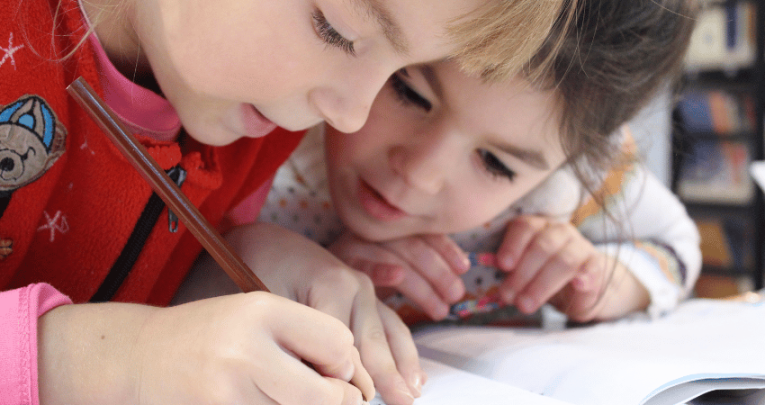Writing club – How to set one up and boost children’s confidence

In the inspiring environment of a well-run writing group, children’s literacy skills will flourish – so why not set up your own?

Lynda set up a lunchtime writing club, ‘Buzzwords’, in her primary school. She began with Year 6 and, after a while, opened the writing club to children across KS2.
Children were given notebooks and encouraged to ‘loosen their writing muscles’ with a range of word hunts, lists and short writing exercises. She found oral anecdotes and memories powerful ways of engaging less confident writers.
She always read aloud a piece of writing to broaden the children’s vocabulary, ideas and structures, and to increase their literary knowledge.
A collection of simple writing prompts also proved effective – pictures, maps, word collections, opening lines and newspaper headlines.
Children were happy to find their own materials and spaces, under desks as well as at them, and to write for 20 minutes.
Lynda established an atmosphere of respectful attention so children who wanted to would read out their work. They were always keen to know their peers’ responses and became fond of each other’s distinctive humour.
Greatest success
In Lynda’s view, children’s increased ease with writing was the club’s greatest success. This was especially the case for children with learning difficulties who had previously under-achieved because of low self-esteem, and for able writers hampered by the limitation of prescribed or over-structured writing tasks.
You may have heard of the National Writing Project UK (NWP UK). Perhaps you have attended one of its growing networks of ‘writing clubs’, which since 2009 have been bringing teachers together to write, share their work and enhance their practice.
But have you considered setting up your own for your school’s children? As the example above illustrates, the results can be well worth the effort…
How to set up a writing club
On your own
Firstly, start writing today! Fix a regular time when you can sit quietly, and aim to write for at least 20 minutes. Sometimes this will be easy, at others hard, but you need to gain confidence to write even when you’re not feeling like it.
Try out the ideas you plan to use with the writing group. Once you’ve done this for a week or so, you’ll be ready to start.
You don’t have to share any of this with your club or class, but it really helps to write alongside pupils, using the same prompts, and to be prepared to show, share and discuss some of the evidence.
With the children
Sound out your individuals and classes. Identify your keen writers. Discuss the idea with them. Establish a convenient time (lunchtime or after school), so that you can meet once a week for at least half a term before you review or change anything.
Engage your enthusiasts by word of mouth, and advertise. In a primary school assembly with about 300 children, one teacher announced the start of her Year 5 and 6 writing club with these words: “I will be doing this in Mrs X’s classroom at lunchtime. If you would like to come along, we’re going to be writing things that we want to write and, you know, it’s for fun, basically.”
17 children came to the first session and 25 to the second. The club is still running after two years.
Get them engaged
- Your club should be fun and stress-free, with a range of quick writing games and short challenges.
- Meet in a quiet place.
- Give each writer a notebook and pen, or encourage them to buy a nice one.
- Establish ground rules about privacy, experimentation, practice, sharing and reflection.
- Write alongside the children.
- Get to know and value the different voices.
- Celebrate diversity and withhold judgement.
- Be prepared for the membership to change over time, but keep the invitations personal and positive, and keep repeating them.
Quick writing exercises for your writing club
You need something easy to break the ice and ‘loosen up the writing muscles’. And if it’s a lunchtime club you have to have an activity “that they can do while they eat their sandwiches…” noted one group’s leader!
The following list may provide some inspiration:
- Titles
- Newspaper headlines
- Opening and closing lines
- Dilemmas
- Lists of words
- Word tiles to arrange
- A simple stem-structure such as “I like…”, “I hate…”
- A ‘scavenger hunt’ of the place you are in
- Freewriting for five minutes without stopping
Agree beforehand whether this writing will be shared or not. It’s often good to have a shared and a private piece – that way children can get into the habit of trusting themselves to have a go, and of letting other, more considered, writing ‘brew’ inside them for a while.
Main writing activities
After a while this is best left to individuals to decide, but at first, some children may appreciate some guidance. Try:
- Extending your writing from one of the first exercises (take a word, idea or phrase as a starting point)
- Writing in voices or from a particular perspective – what the woman in the picture was really thinking; how the artefact came to be here; what the tree remembers
- Using snatches of overheard conversations or ‘found’ phrases to launch you into your own writing
- Finding an object/picture/view that interests you and write about it twice, moving your writing position/perspective to do so – once from one point of view, once from another
Again, agree beforehand how you will share the writing that takes place.
Establish ground rules, for example, listening to each other attentively and not being afraid just to say thank you. It’s useful to model how to respond to the writing process, rather than the product:
- Where did you get your ideas from?
- Which words/parts came easily and where did you struggle?
- What would you like to do next with your writing?
When children are ready to share, model attentive listening to tone and content (it helps to hear the writing before you see it).
This process may be better in pairs at first, but where possible it’s fascinating to read around the group and hear what different writing has emerged during the session from similar stimuli.
Taking it further
You might like to enhance your group by writing together online. Most schools have a VLE with separate forums that can be closed except to those who are password approved.
This enables all children to see each others’ writing and give feedback. A teacher of one Year 6 class said that the biggest boost to children’s writing confidence came from appreciation and suggestions from their peer group.
Resources for your writing club
The following items will help keep your children inspired for hours…
- Small boxes and envelopes, plain and coloured paper, card
- A range of writing implements
- Collections of postcards, pictures, quotations
- A book box with novels, picture books and poetry
- Magazines and newspapers to cut up
- CD/DVDs: music, short films or clips
- Ephemeral texts – newsletters, tickets brochures, catalogues and packaging
- A props box, hats and scarves, glasses, glove puppets
- A collection of objects – buttons, fir cones, jewellery, toys, bric-abrac, shells, stones
Once the group is established, it’s good to ask children to bring and add ideas, texts, objects, pictures, DVDs of their own.
This article is an edited extract of Introducing Teachers’ Writing Groups by Jenifer Smith and Simon Wrigley (Routledge), which is available now. It explains the importance of said groups and offers guidance on setting up your own. Browse more ideas for National Writing Day.










